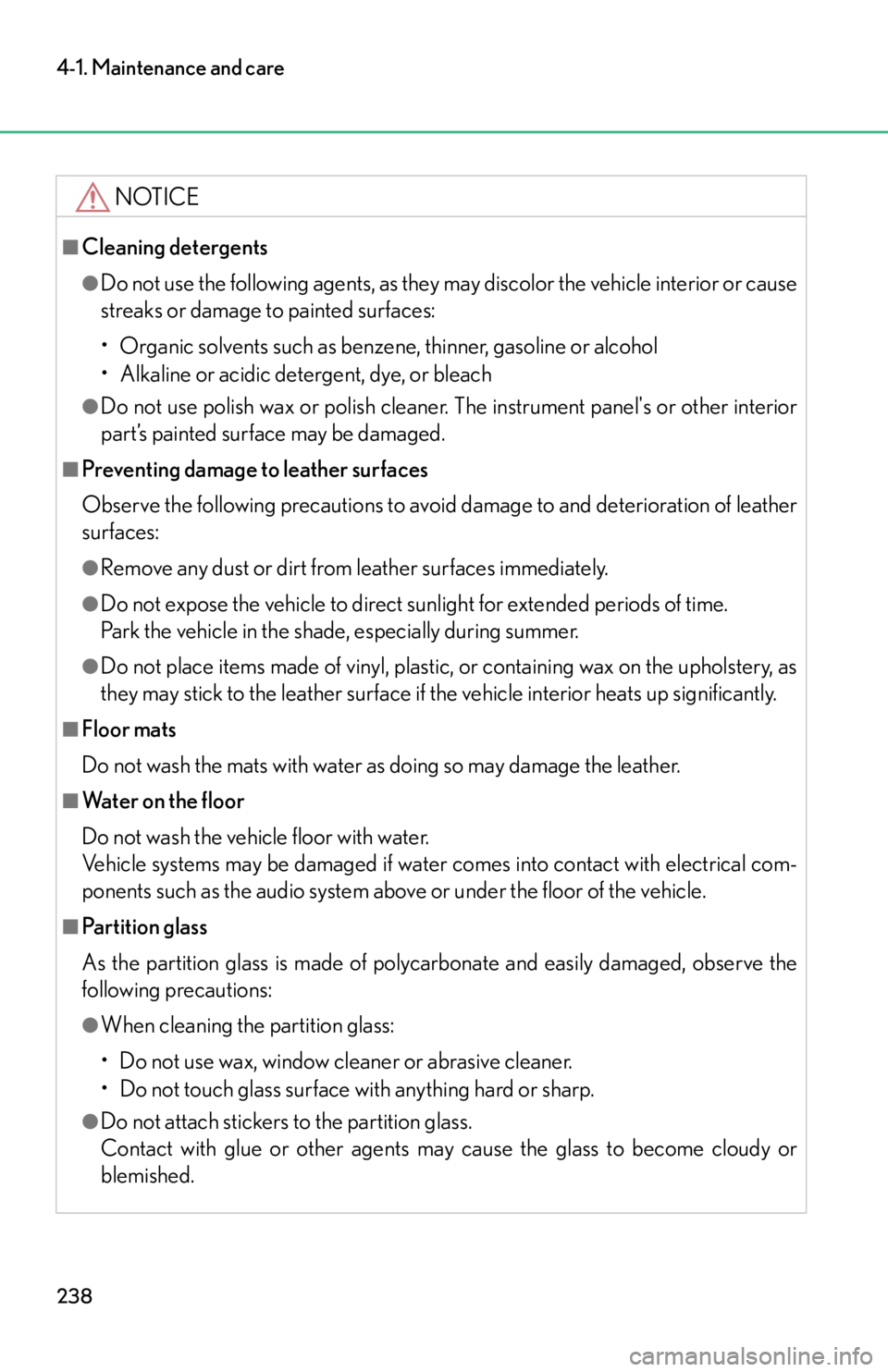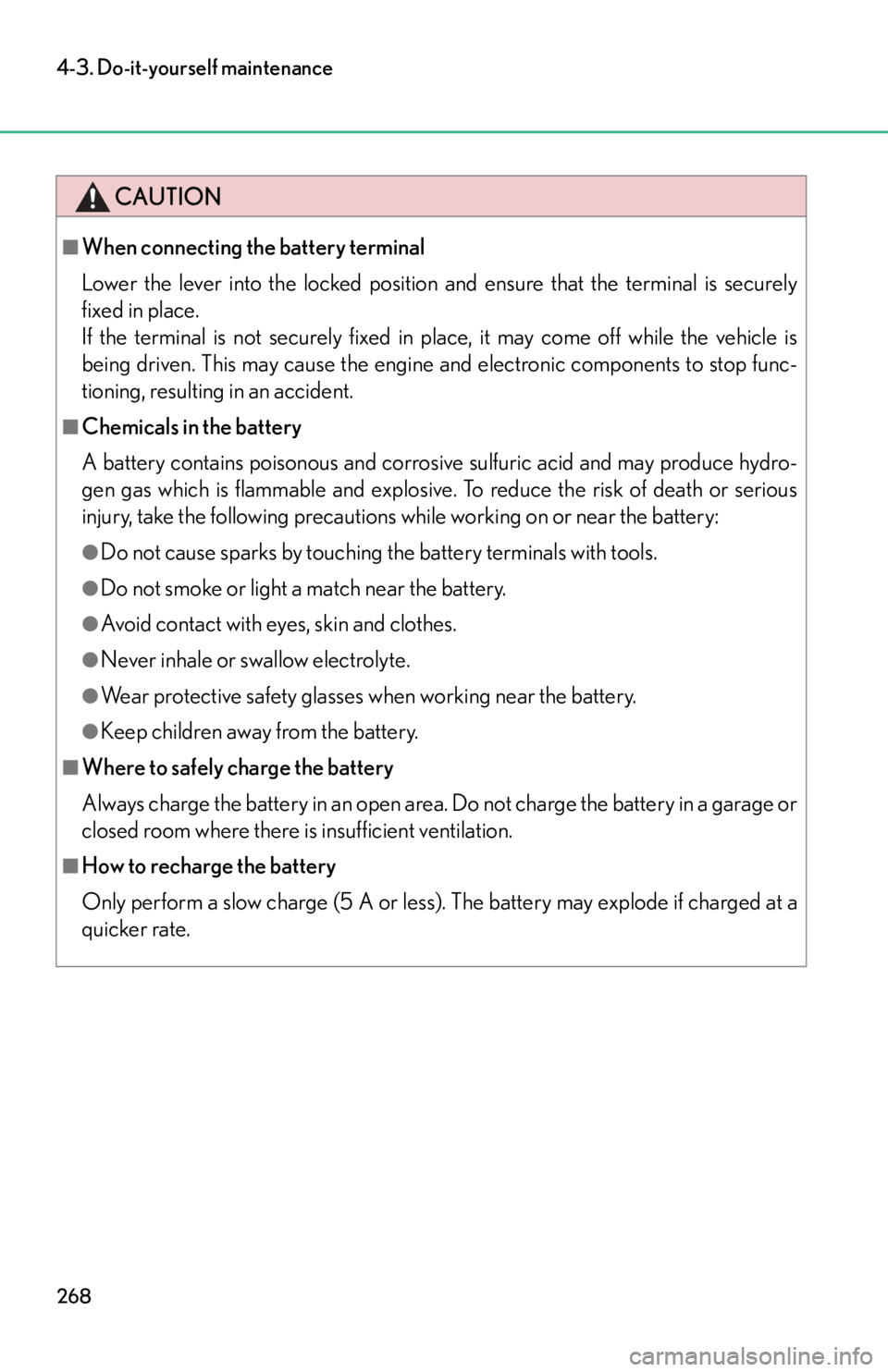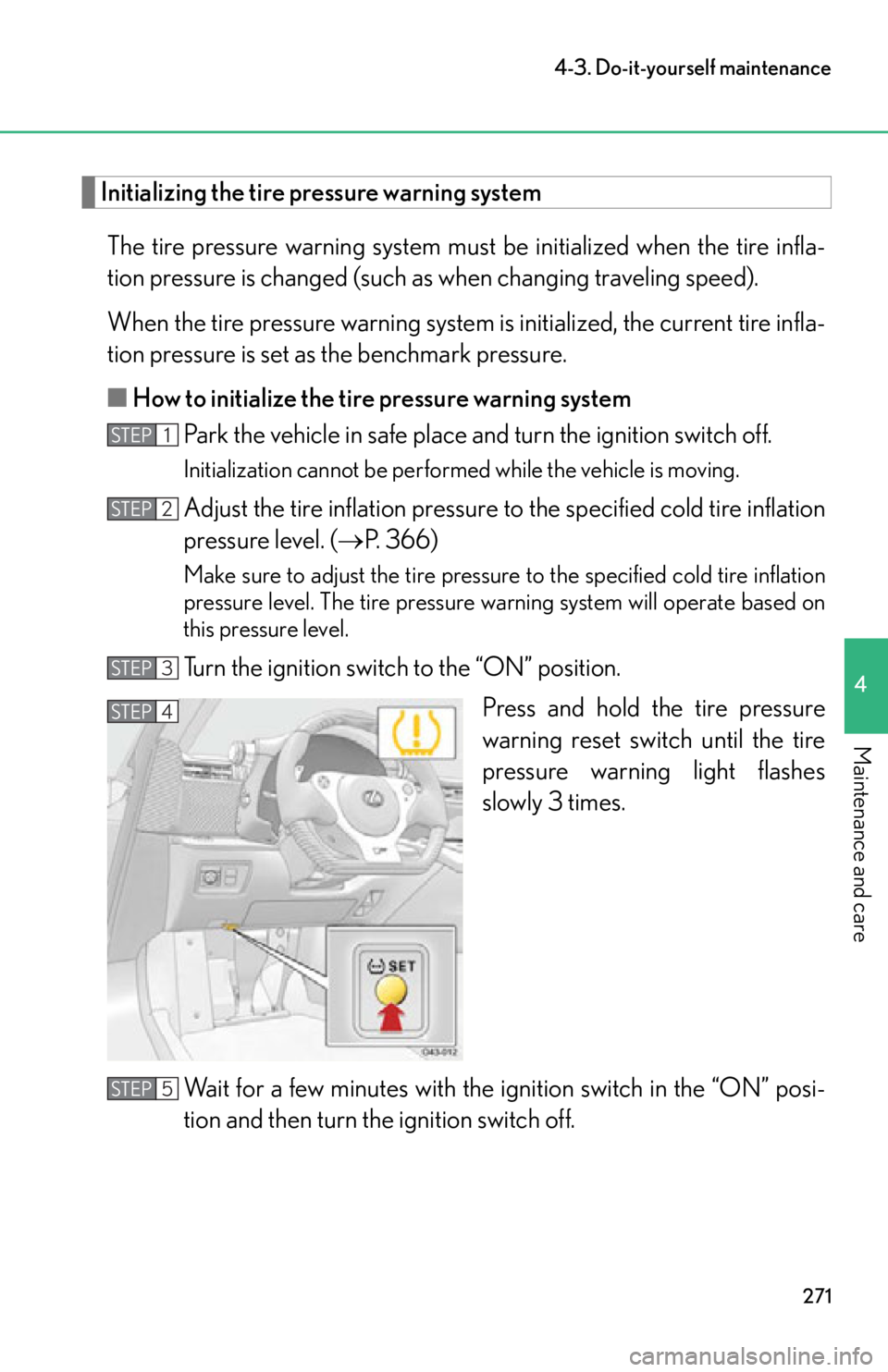Page 234 of 420
232
4-1. Maintenance and care
NOTICE
■When washing the vehicle
Observe the following precautions to prevent damage to the exhaust system:
■Cleaning the exterior lights
●Wash carefully. Do not use organic substances or scrub with a hard brush.
This may damage the surfaces of the lights.
●Do not apply wax on the surfaces of the lights.
Wax may cause damage to the lenses.
●Do not flush water over or into the hood
grilles (especially the arrowed portion in
the illustration).
●Do not flush water over or into the exhaust
pipes and surrounding area or the bezels in
the radiator grilles until they have cooled
sufficiently.
Page 240 of 420

238
4-1. Maintenance and care
NOTICE
■Cleaning detergents
●Do not use the following agents, as they may discolor the vehicle interior or cause
streaks or damage to painted surfaces:
• Organic solvents such as benzene, thinner, gasoline or alcohol
• Alkaline or acidic detergent, dye, or bleach
●Do not use polish wax or polish cleaner. The instrument panel's or other interior
part’s painted surface may be damaged.
■Preventing damage to leather surfaces
Observe the following precautions to avoid damage to and deterioration of leather
surfaces:
●Remove any dust or dirt from leather surfaces immediately.
●Do not expose the vehicle to direct sunlight for extended periods of time.
Park the vehicle in the shade, especially during summer.
●Do not place items made of vinyl, plastic, or containing wax on the upholstery, as
they may stick to the leather surface if the vehicle interior heats up significantly.
■Floor mats
Do not wash the mats with water as doing so may damage the leather.
■Water on the floor
Do not wash the vehicle floor with water.
Vehicle systems may be damaged if water comes into contact with electrical com-
ponents such as the audio system above or under the floor of the vehicle.
■Pa r t i t i o n g l a s s
As the partition glass is made of polyca rbonate and easily damaged, observe the
following precautions:
●When cleaning the partition glass:
• Do not use wax, window cl eaner or abrasive cleaner.
• Do not touch glass surface with anything hard or sharp.
●Do not attach stickers to the partition glass.
Contact with glue or other agents ma y cause the glass to become cloudy or
blemished.
Page 245 of 420
243
4-2. Maintenance
4
Maintenance and care
Vehicle interior
ItemsCheck points
Accelerator pedal • The accelerator pedal should move
smoothly (without uneven pedal
effort or catching).
Brake pedal • Does the brake pedal move
smoothly?
• Does the brake pedal have appro- priate clearance from the floor?
( P. 3 6 4 )
• Does the brake pedal have the cor- rect amount of free play?
( P. 3 6 4 )
Brakes • The vehicle should not pull to one
side when the brakes are applied.
• The brakes should work effectively.
• The brake pedal should not feel
spongy.
• The brake pedal should not get too close to the floor when the brakes
are applied.
Indicators/buzzers • Do the indicators and buzzers
function properly?
Lights • Do all the lights come on?
Pa r k i n g b r a ke • When parked on a slope and the
parking brake is on, is the vehicle
securely stopped?
Seat belts • Do the seat belts operate
smoothly?
• The seat belts should not be dam- aged.
Page 252 of 420
250
4-3. Do-it-yourself maintenance
Hood
Release the lock from the inside of the vehicle to open the hood.
Pull the hood release lever.
The hood will pop up slightly.
Press the auxiliary catch lever to
the left and lift the hood.
Take out the supporting rod.
STEP1
STEP2
STEP3
Page 265 of 420
263
4-3. Do-it-yourself maintenance
4
Maintenance and care
NOTICE
■If the fluid level is low or high
It is normal for the brake fluid level to go down slightly as the brake pads wear out or
when the fluid level in the accumulator is high.
If the reservoir needs frequent refilling, there may be a serious problem.
Page 270 of 420

268
4-3. Do-it-yourself maintenance
CAUTION
■When connecting the battery terminal
Lower the lever into the locked position and ensure that the terminal is securely
fixed in place.
If the terminal is not securely fixed in place, it may come off while the vehicle is
being driven. This may cause the engine and electronic components to stop func-
tioning, resulting in an accident.
■Chemicals in the battery
A battery contains poisonous and corrosive sulfuric acid and may produce hydro-
gen gas which is flammable and explosive. To reduce the risk of death or serious
injury, take the following precautions while working on or near the battery:
●Do not cause sparks by touching the battery terminals with tools.
●Do not smoke or light a match near the battery.
●Avoid contact with eyes, skin and clothes.
●Never inhale or swallow electrolyte.
●Wear protective safety glasses when working near the battery.
●Keep children away from the battery.
■Where to safely charge the battery
Always charge the battery in an open area. Do not charge the battery in a garage or
closed room where there is insufficient ventilation.
■How to recharge the battery
Only perform a slow charge (5 A or less). The battery may explode if charged at a
quicker rate.
Page 273 of 420

271
4-3. Do-it-yourself maintenance
4
Maintenance and care
Initializing the tire pressure warning systemThe tire pressure warning system must be initialized when the tire infla-
tion pressure is changed (such as when changing traveling speed).
When the tire pressure warning system is initialized, the current tire infla-
tion pressure is set as the benchmark pressure.
■ How to initialize the tire pressure warning system
Park the vehicle in safe place and turn the ignition switch off.
Initialization cannot be performed while the vehicle is moving.
Adjust the tire inflation pressure to the specified cold tire inflation
pressure level. ( P. 366)
Make sure to adjust the tire pressure to the specified cold tire inflation
pressure level. The tire pressure warning system will operate based on
this pressure level.
Turn the ignition switch to the “ON” position.
Press and hold the tire pressure
warning reset switch until the tire
pressure warning light flashes
slowly 3 times.
Wait for a few minutes with th e ignition switch in the “ON” posi-
tion and then turn the ignition switch off.
STEP1
STEP2
STEP3
STEP4
STEP5
Page 274 of 420

272
4-3. Do-it-yourself maintenance
Registering ID codesThe tire pressure warning valve and transmitter is equipped with a unique
ID code. When replacing a tire pressu re warning valve and transmitter, it
is necessary to register the ID code. Ha ve the ID code registered by your
Lexus dealer.
■When to replace your vehicle’s tires
Tires should be replaced if:
●You have tire damage such as cuts, splits, cracks deep enough to expose the
fabric or bulges indicating internal damage
●A tire goes flat repeatedly or cannot be properly repaired due to the size or
location of a cut or other damage
If you are not sure, consult with your Lexus dealer.
■Replacing tires and wheels
If the ID code of the tire pressure warning valve and transmitter is not registered,
the tire pressure warning system will not work properly. After driving for about 20
minutes, the tire pressure warning light fl ashes for 1 minute to indicate a system mal-
function.
■Tire life
Any tire over 6 years old must be checked by a qualified technician even if they
have seldom or never been used or damage is not obvious.
■Routine tire inflation pressure checks
The tire pressure warning system does not replace routine tire inflation pressure
checks. Make sure to check tire inflation pressure as part of your routine of daily
vehicle checks.
■Tire rotation
It is not possible to rotate the tires, as each tire is designed only for its original posi-
tion on the vehicle.